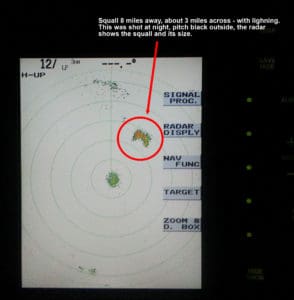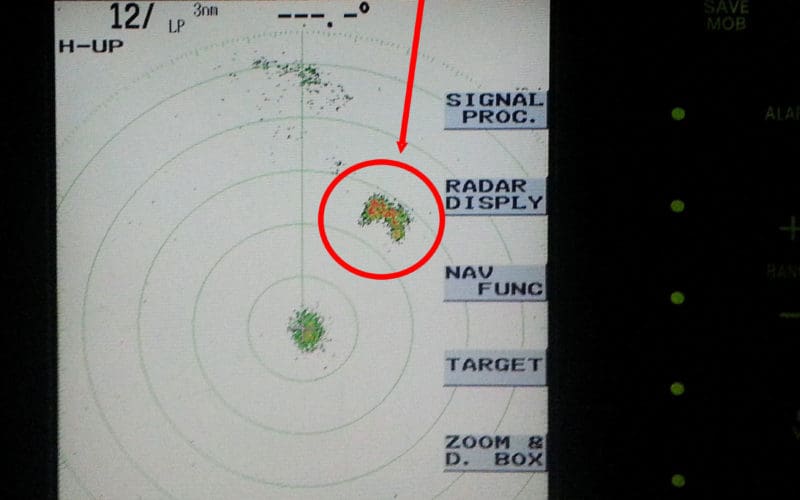 In 2003 I installed a radar on my 1983 Morgan N/M 456, Tiger Beetle, to help with singlehanded races between San Francisco and Hawaii. The Furuno 4 kilowatt 24-inch radome I went with was one of the better small boat radars. The 24-inch-wide antenna provided better angular resolution than an 18-inch antenna, the 4 kilowatt power punched well through rain, and it had a guard zone/sleep feature to conserve power. I would set up the guard zone on the black and white display and targets that entered the guard zone would sound an alarm so I could check the target. I kept the range at eight miles as it’s difficult for me to pick out shipping with binoculars beyond that distance. The radar worked well and I used it until 2021.
In 2003 I installed a radar on my 1983 Morgan N/M 456, Tiger Beetle, to help with singlehanded races between San Francisco and Hawaii. The Furuno 4 kilowatt 24-inch radome I went with was one of the better small boat radars. The 24-inch-wide antenna provided better angular resolution than an 18-inch antenna, the 4 kilowatt power punched well through rain, and it had a guard zone/sleep feature to conserve power. I would set up the guard zone on the black and white display and targets that entered the guard zone would sound an alarm so I could check the target. I kept the range at eight miles as it’s difficult for me to pick out shipping with binoculars beyond that distance. The radar worked well and I used it until 2021.
Offshore the radar will pick up ships but for me an even more useful role is detecting squalls, particularly at night when they are most prevalent. Squalls introduce a local wind shift and speed increase as they approach. During the day squalls are easy to see — they are large dark columns of rain beneath towering clouds, and the ones of interest are usually overtaking from astern. At night it’s more difficult to spot them — mostly I look for dark areas in the sky where the stars are missing.
The Furuno is a magnetron radar and has a rain clutter function for tuning the fast time constant (FTC) control to set the time duration and minimum intensity of a pulse return to display; rain returns have a long duration and low intensity relative to a hard target ship return. The result is tuning FTC can determine how much of the rain return gets through to the display, meaning I can tune the FTC specifically to enhance the rain return — and voila! — squalls turn into giant green blobs on the screen.
A limitation of a magnetron-based radar is determining the target’s relative motion — is it approaching, paralleling, or going away? With the magnetron radar I would get up and watch the radar screen for eight to 10 minutes to see if I could figure out which way the spot on the screen was moving. If I couldn’t figure it out I’d go on deck with binoculars to have a look for the ship’s navigation lights — not much fun when I’m dog-tired at 0300. This is where frequency shift radar works better — the radar is measuring the target return frequency shift and can immediately determine the target’s relative motion. In effect, frequency shift radar brings the 1940s magnetron radar up to the 1960s radar technology — but at a price point, size, and power consumption that a smaller boat can afford to operate.
When I updated Beetle’s radar I was looking for two things: frequency shift detection to quickly determine relative motion, and still be able to tune to see squalls. I had done some sleuthing of current radar technology two years ago while researching radars for my brother’s power boat. I learned that much has changed, starting in 2009 with the introduction of frequency modulated continuous wave (FMCW) for the small boat market. FMCW radar broadcasts a continuous linear radio wave of increasing frequency, completely unlike the single frequency ‘big bang’ of a magnetron radar. FMCW frequency emissions are tightly controlled and do not produce the wide radio frequency splatter of the magnetron, resulting in increased signal to noise ratio and therefore the FMCW radar is excellent at pulling targets out of the background noise.
The primary downside to the first three generations of small boat FMCW radars is limited range —they were excellent for nearby targets, but the magnetron radars were significantly better at picking up distant targets, at least for the 24-inch radome size I use. The key to range is either a ton of power (magnetron) or selecting the right frequency (FMCW) — use longer frequencies for distant targets, shorter frequencies for nearby targets.
The fourth generation “chirp” radars solved the problem of frequency selection by broadcasting multiple frequencies in one sweep using a discontinuous multiple discrete chirps at differing frequencies (as opposed to FMCW), and listening for return signals in between chirps. Each discrete chirp frequency has a min/max range (a donut ring) of the greatest signal-to-noise ratio. As the antenna is collecting the return signals a lot of computing horsepower is used to assemble the donut range rings into a single cohesive image that makes sense to a person. The result is a crispy image with reduced noise as compared to a magnetron radar, while the range approaches that of a magnetron radar. Add a Doppler frequency shift analysis of the return signal and the radar can determine target relative motion immediately.
All of the information from the chirp Doppler radar is digitized early in the signal processing model, and digitized information lends itself to computer enhancement. To look at the two key features I wanted, target relative movement is depicted with color: targets moving towards me are yellow, those going away are blue, everything stable is red — this is the Doppler shift frequency analysis. I can tune the rain clutter control to specifically pick up squalls when I want to. Rain interference/noise is referred to as volumetric clutter, and there are a variety of ways to handle such clutter. I talked with the vendor for my radar (B&G Halo 24) and, interestingly enough, they weren’t sure how the rain clutter function actually worked —leading me to suspect B&G doesn’t actually make the radar.
I’m pleased to have made the shift from 1940s to 1960s military technology and I expect something’s been going on for the last 70 years in the radar world as people have been working on it. Arguably the best things for me as a boater are the automotive industry’s interest in radar-on-a-chip for cars, the use of Gallium Nitride X-band amplifiers in the cellular telephone industry, and the powerful chips used in laptops and cell phones — I suspect everyone benefits significantly in terms of reduced component prices.
The are multiple vendors of the Chirp frequency shift radars, including: Simrad (includes Lowrance, B&G), Garmin, Raymarine, and Furuno. I went with the B&G as I have used their instruments extensively and already had a B&G chart plotter which can double as a radar display and controller. The radar does a good job detecting targets and displays detailed information on nearby (less than eight mile distant) targets. The unit does not work as well at picking up distant (20+ mile range) targets compared to my older Furuno magnetron radar. I’m unimpressed with the marketing-speak of “instant on” — it’s not “instant on,” it takes about 30 seconds for the radar to boot up and start operating. Seems that marketing departments have redefined the word “instant.” Still, a significant improvement over the two to three minutes for the magnetron radar.
This is an interesting time in the small boat radar world, and I’m impressed with the chirp and Doppler frequency shift detecting radars. If anyone out there is wondering if a radar update or replacement would be useful, it’s worthwhile taking a look at what the 4th generation of radars has to offer. And then you can go squall-spotting!
Rob MacFarlane has singlehandedly raced and cruised for 30 years on San Francisco Bay, the West Coast, to Hawaii, Mexico, Canada and French Polynesia. He sails the 1983 Morgan N/M 456 IOR two tonner, Tiger Beetle.

